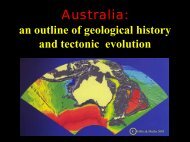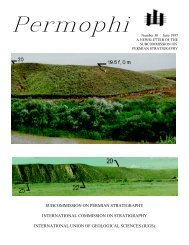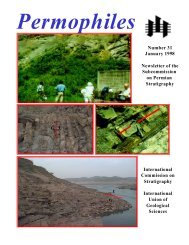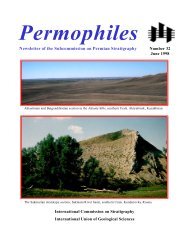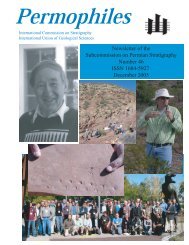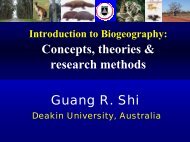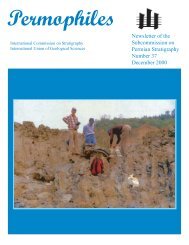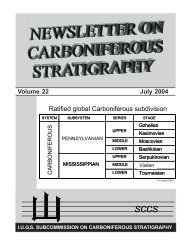<strong>Permophiles</strong> Issue #39 2001carbonate in the middle part. The Heshan Formation, 270 m inthickness at Penglaitan, is mostly composed of chert andlenticular limestone of basinal facies. Reefal carbonates of theLate Wuchiapingian are reduced to 10 m in thickness.Depositional sequence of the G/L boundary interval“If major natural changes in the historical development ofthe Earth can be identified at specific points in sequences ofcontinuous deposition, these may constitute desirable points forthe boundary-stratotypes of stages.” (Hedberg, 1977). TheGuadalupian-Lopingian boundary coincides with the boundarysurface between the Middle and the Upper AbsarokaMegasequences that is caused by an important event of globalsea-level change. A regional survey of Guadalupian-Lopingianboundary successions shows that the Laibin Limestone representsa lowstand systems tract deposited on the slope duringthe Guadalupian-Lopingian boundary interval; this interval isprobably characterized by an unconformity in all other shelfsections (Fig.3).From Member IV of the Maokou Formation to the LaibinLimestone, chert and cherty carbonate mudstone of shelf tobasinal facies change into grainstones and packstones of distaltempestite facies. This marks a rapid shallowing as severaltransitional facies units are missing in-between. The lower partof the Laibin Limestone (Bed 2-5 in Tieqiao; Bed 2-3 inPenglaitan) is characterized by packstone of tempestite faciesand wackestone with rich algal lamellae that exhibit continuousshallowing. Well-developed stylolites in Bed 5 of the TieqiaoSection may have formed at an interval indicating submarineerosion or non-deposition. Faunal changes further prove thatBed 3 - Bed 5 (except the upper part) in Tieqiao and Bed 3(except the topmost part) in Penglaitan represent the deposits ofthe near-shore Hindeodus conodont biofacies, which is interpretedas at or near the maximum regression in the Laibin area.The Guadalupian-Lopingian succession of conodont faunas wasdominated by gondolellid conodonts that inhabited deeperenvironments as a whole, but was interrupted briefly by thedominance of a shallow water conodont fauna, the Hindeodussp. interval, in Beds 3, 4 and most of Bed 5 at the Tieqiao Sectionand Bed 3 (except the topmost part) at the Penglaitan Section.Brachiopods, corals and other shallow-water benthic fossils arefrequently present in these beds. Accordingly, the sequenceboundary or the maximum regression lies on the top of Bed 5 atTieqiao, and the top of Bed 3 at Penglaitan.The top of the uppermost shallowing-upward cycle of the“lowstand” unit is the transgressive surface (Van Wagoner etal., 1988, 1990). The late lowstand or early transgressive systemstract (Bed 5f to Bed 6j in Tieqiao, Bed 3c6 to Bed 6k inPenglaitan) contain thick-bedded crinoid grainstone andlenticular packstone that reflect the beginning of an overalldeepening. These rocks consist of high frequency cycles ofdeposition. Each cycle is dominated by the hummocky, crossstratifiedcrinoid grainstone in the lower portion and lenticularpackstone in the upper, often with vertical burrows or infillingstructures at the top. The facies change is interpreted to rangefrom fine-grained deposits of relatively deeper below-wave-basefacies to an intertidal environment. The conodonts of theJinogondolella granti and Clarkina postbitteri sensu latozones are associated with deposition of the latest lowstand andearliest TST, and occur mostly in the lenticular packstone. It isobvious that there were minor depositional hiatuses between allof the cycles; however, none of them are significant in terms ofthe resolution of conodont chronostratigraphy because most ofthem occur within the same conodont zone.The last two cycles of the Laibin Limestone in thePenglaitan Section are respectively composed of Bed 6g - 6ilowerand Bed 6i-upper to 6k. No measurable time break isevident between or within these cycles though evidence forsuspected depositional gaps have been observed in bothcandidate boundary levels. Wavy bedding between the neighboringcouplets is distinct; well-developed burrows are onlyseen from the upper part of Bed 6k. Bed 6h and 6i-lower arecoarse crinoidal grainstone, which contain very rare conodontfragments, but fish remains and small gastropods are morecommon. Bed 6i-upper comprises mostly packstone with somecarbonate mudstone intraclasts. Bed 6j contains abundantmudstone intraclasts and numerous small solitary corals. Thisbed is inconsistent in thickness and consequently Bed 6k maycontact directly with Bed 6i–upper. The intraclasts were interpretedas consolidated carbonate breccia that were reworked bystorms and introduced into the Penglaitan deposits duringsubsequent rising sea level. In the Tieqiao Section Bed C8 canbe correlated with Bed 6j in the Penglaitan Section since bothbeds comprise abundant mudstone intraclasts, numerous smallsolitary corals and Clarkina postbitteri hongshuiensis. It ispossible that the corresponding part of Bed 6h to 6i-lower fromthe Penglaitan Section is missing at the Tieqiao Section becausethere Bed 6i with abundant C. postbitteri sensu lato lies directlyover Bed 6h that contains abundant Jinogondolella granti justas Bed 6g from the Penglaitan Section does (Henderson et al., inpress). Applying the transgressive-regressive sequence modelof Embry (1988, 1990), this point could be viewed as the beginningof a new sequence within a conformable succession.The subsequent transgressive unit (Bed 7) in Penglaitan iscomposed of high-frequency cycles that overall deepen upward;the cycles consist of lenticular mud limestone deposited belowstorm-wave-base to chert of the shelf to basinal facies, with orwithout clay bed at the base. This transgressive unit is aresponse to the very rapid sea-level rise at the time of the C.dukouensis Zone.To sum up, the Laibin Limestone can be referred to as an“intersequence”, resulting from the lowstand of sea level inareas that were previously in a deep-water position. It wasdeposited during the late parts of sea level fall and early parts ofsea level rise. The supposed correlative conformable surfaceassociated with the Guadalupian - Lopingian sequence boundaryon the platform can be placed around this level. Bed 6i-upperindicates a much faster and widespread transgression starting inthe top part of the Laibin Limestone. The flooding event isdelineated by the occurrence of the C. postbitteri sensu latoconodont Zone in Beds 6i-upper to 6k at the Penglaitan Section,which might extend northward to the ChengzhouBasin of southern Hunan, far beyond the distribution ofunderlying conodonts from the J. granti Zone.34
<strong>Permophiles</strong> Issue #39 2001BiostratigraphyConodont zoneSys.TractUnitSedimentaryfeaturesLaibinPenglaitanLaibinTieqiaoLiuchengFengshanHeshanMatanXuanhanDukouC. transcaucasicaC. guangyuanensisC. asymmetricaHSTTST6 progradationdownlapdeep basinfaciesmfs deepest5OnlapretrogradationHeshan FormationFAD C. postbitterihongshuiensisFAD C. postbitteripostbitteriFADC. dukouensisC. dukouensisClarkina postbitteripostbitteriC. p. hongshuiensisJinogondolellagrantiHindeodusexcavatus6j 6kupper 6ilower 6iLSTHST 2fsfs4fs 32initial floodingprogradationalmargin wedgeupwardshallowingLaibin Limestone? ?J. xuanhanensisJ. prexuanhanensisJ. altudaensisHST 11deepbasinfaciesMaokou Fm.5m01234567891011Biostratigraphic boundary12Disconformable surface-variable duration1314Correlative conformity1516Base ofLaibin Limestone1718fs =flooding surface-variable magnitudeFigure 3. Sequence biostratigraphic diagram showing lithology, key sequence stratigraphic surfaces and biozonal boundaries for fivekey sections. The figure highlights the complete nature of the succession at Penglaitan and the hiatus at shelf sections likeMatan and Dukou (provided by Chen Zhongqiang and Jin Yugan).Fossil successionsConodonts from the Laibin Limestone (Fig. 4) in bothTieqiao and Penglaitan sections are exclusively dominated byJinogondolella species in the basal part (Bed 2 at Tieqiao andBed 2 at Penglaitan) and by Clarkina species in the uppermostpart (Bed 6i to Bed 8 at Tieqiao and Bed 6i-upper to 6k atPenglaitan). The lower part of the Laibin Limestone (Bed 3 to themiddle of Bed 5 at Tieqiao; Bed 3 (except the uppermost part) atPenglaitan) is dominated by Hindeodus. Rare specimens ofshallow water elements like Sweetognathus fengshanensis andIranognathus erwini were also recovered respectively within thelower Bed 3 and 6k at Penglaitan. Jinogondolella and Clarkinaspecies also dominate conodonts from equivalent beds at theFengshan Section, but contain more common to abundantnearshore shallow water elements Hindeodus, Sweetognathusfengshanensis, Iranognathus erwini, and Sweetina (in order of35decreasing abundance). Based on the stratigraphic range andevolution of species of Jinogondolella and Clarkina, threephylogenetic conodont zones are recognized around theGuadalupian-Wuchiapingian boundary in Tieqiao andPenglaitan sections: the Jinogondolella granti Zone rangesfrom upper part of Bed 5 through Bed 6h in the Tieqiao Section,and from the uppermost Bed 3 through 6i-lower (4.8m thick) inthe Penglaitan Section; the Clarkina postbitteri sensu latoZone ranges from Bed 6i through lower Bed 9 in the TieqiaoSection, and from 6i-upper through 7b (there are no conodontsfrom bed 7c and 7d) in the Penglaitan Section; the Clarkinapostbitteri sensu lato Zone is overlain by the Clarkinadukouensis Zone that starts at Bed 7e in the Penglaitan Section.Recently, the Clarkina postbitteri sensu lato Zone in thePenglaitan section has been subdivided into two subzones: thelower Clarkina postbitteri hongshuiensis subsp. nov. Subzoneranges through beds 6i-upper and 6j, and the upper Clarkina



